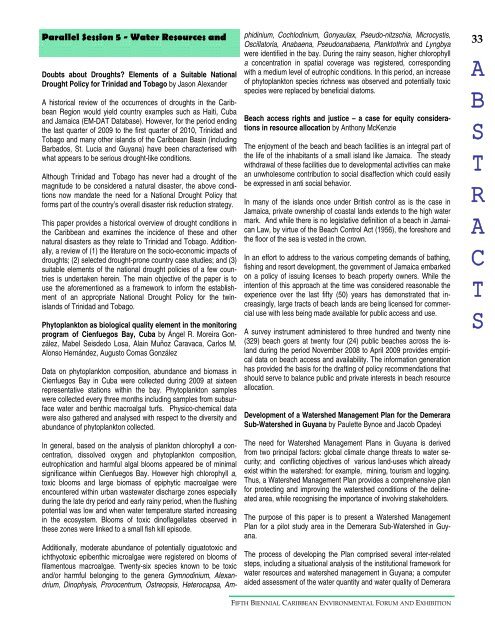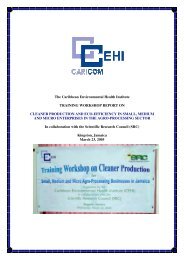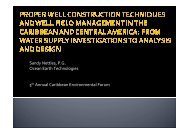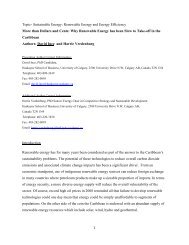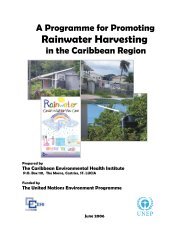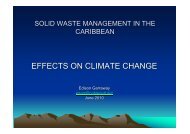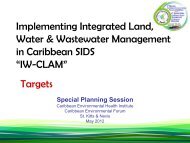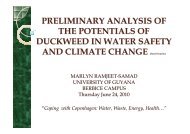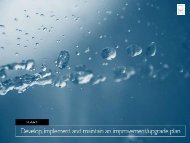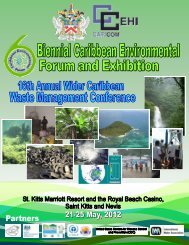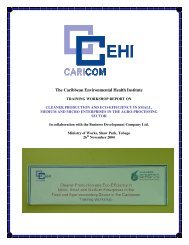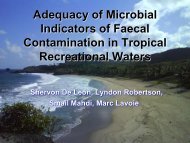conference magazine - Caribbean Environmental Health Institute
conference magazine - Caribbean Environmental Health Institute
conference magazine - Caribbean Environmental Health Institute
Create successful ePaper yourself
Turn your PDF publications into a flip-book with our unique Google optimized e-Paper software.
Parallel Session 5 - Water Resources and<br />
Doubts about Droughts? Elements of a Suitable National<br />
Drought Policy for Trinidad and Tobago by Jason Alexander<br />
A historical review of the occurrences of droughts in the <strong>Caribbean</strong><br />
Region would yield country examples such as Haiti, Cuba<br />
and Jamaica (EM-DAT Database). However, for the period ending<br />
the last quarter of 2009 to the first quarter of 2010, Trinidad and<br />
Tobago and many other islands of the <strong>Caribbean</strong> Basin (including<br />
Barbados, St. Lucia and Guyana) have been characterised with<br />
what appears to be serious drought-like conditions.<br />
Although Trinidad and Tobago has never had a drought of the<br />
magnitude to be considered a natural disaster, the above conditions<br />
now mandate the need for a National Drought Policy that<br />
forms part of the country’s overall disaster risk reduction strategy.<br />
This paper provides a historical overview of drought conditions in<br />
the <strong>Caribbean</strong> and examines the incidence of these and other<br />
natural disasters as they relate to Trinidad and Tobago. Additionally,<br />
a review of (1) the literature on the socio-economic impacts of<br />
droughts; (2) selected drought-prone country case studies; and (3)<br />
suitable elements of the national drought policies of a few countries<br />
is undertaken herein. The main objective of the paper is to<br />
use the aforementioned as a framework to inform the establishment<br />
of an appropriate National Drought Policy for the twinislands<br />
of Trinidad and Tobago.<br />
Phytoplankton as biological quality element in the monitoring<br />
program of Cienfuegos Bay, Cuba by Ángel R. Moreira González,<br />
Mabel Seisdedo Losa, Alain Muñoz Caravaca, Carlos M.<br />
Alonso Hernández, Augusto Comas González<br />
Data on phytoplankton composition, abundance and biomass in<br />
Cienfuegos Bay in Cuba were collected during 2009 at sixteen<br />
representative stations within the bay. Phytoplankton samples<br />
were collected every three months including samples from subsurface<br />
water and benthic macroalgal turfs. Physico-chemical data<br />
were also gathered and analysed with respect to the diversity and<br />
abundance of phytoplankton collected.<br />
In general, based on the analysis of plankton chlorophyll a concentration,<br />
dissolved oxygen and phytoplankton composition,<br />
eutrophication and harmful algal blooms appeared be of minimal<br />
significance within Cienfuegos Bay. However high chlorophyll a,<br />
toxic blooms and large biomass of epiphytic macroalgae were<br />
encountered within urban wastewater discharge zones especially<br />
during the late dry period and early rainy period, when the flushing<br />
potential was low and when water temperature started increasing<br />
in the ecosystem. Blooms of toxic dinoflagellates observed in<br />
these zones were linked to a small fish kill episode.<br />
Additionally, moderate abundance of potentially ciguatotoxic and<br />
ichthyotoxic epibenthic microalgae were registered on blooms of<br />
filamentous macroalgae. Twenty-six species known to be toxic<br />
and/or harmful belonging to the genera Gymnodinium, Alexandrium,<br />
Dinophysis, Prorocentrum, Ostreopsis, Heterocapsa, Am-<br />
phidinium, Cochlodinium, Gonyaulax, Pseudo-nitzschia, Microcystis,<br />
Oscillatoria, Anabaena, Pseudoanabaena, Planktothrix and Lyngbya<br />
were identified in the bay. During the rainy season, higher chlorophyll<br />
a concentration in spatial coverage was registered, corresponding<br />
with a medium level of eutrophic conditions. In this period, an increase<br />
of phytoplankton species richness was observed and potentially toxic<br />
species were replaced by beneficial diatoms.<br />
Beach access rights and justice – a case for equity considerations<br />
in resource allocation by Anthony McKenzie<br />
The enjoyment of the beach and beach facilities is an integral part of<br />
the life of the inhabitants of a small island like Jamaica. The steady<br />
withdrawal of these facilities due to developmental activities can make<br />
an unwholesome contribution to social disaffection which could easily<br />
be expressed in anti social behavior.<br />
In many of the islands once under British control as is the case in<br />
Jamaica, private ownership of coastal lands extends to the high water<br />
mark. And while there is no legislative definition of a beach in Jamaican<br />
Law, by virtue of the Beach Control Act (1956), the foreshore and<br />
the floor of the sea is vested in the crown.<br />
In an effort to address to the various competing demands of bathing,<br />
fishing and resort development, the government of Jamaica embarked<br />
on a policy of issuing licenses to beach property owners. While the<br />
intention of this approach at the time was considered reasonable the<br />
experience over the last fifty (50) years has demonstrated that increasingly,<br />
large tracts of beach lands are being licensed for commercial<br />
use with less being made available for public access and use.<br />
A survey instrument administered to three hundred and twenty nine<br />
(329) beach goers at twenty four (24) public beaches across the island<br />
during the period November 2008 to April 2009 provides empirical<br />
data on beach access and availability. The information generation<br />
has provided the basis for the drafting of policy recommendations that<br />
should serve to balance public and private interests in beach resource<br />
allocation.<br />
Development of a Watershed Management Plan for the Demerara<br />
Sub-Watershed in Guyana by Paulette Bynoe and Jacob Opadeyi<br />
The need for Watershed Management Plans in Guyana is derived<br />
from two principal factors: global climate change threats to water security;<br />
and conflicting objectives of various land-uses which already<br />
exist within the watershed: for example, mining, tourism and logging.<br />
Thus, a Watershed Management Plan provides a comprehensive plan<br />
for protecting and improving the watershed conditions of the delineated<br />
area, while recognising the importance of involving stakeholders.<br />
The purpose of this paper is to present a Watershed Management<br />
Plan for a pilot study area in the Demerara Sub-Watershed in Guyana.<br />
The process of developing the Plan comprised several inter-related<br />
steps, including a situational analysis of the institutional framework for<br />
water resources and watershed management in Guyana; a computer<br />
aided assessment of the water quantity and water quality of Demerara<br />
33<br />
A<br />
B<br />
S<br />
T<br />
R<br />
A<br />
C<br />
T<br />
S<br />
FIFTH BIENNIAL CARIBBEAN ENVIRONMENTAL FORUM AND EXHIBITION


